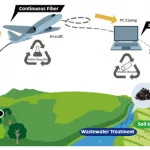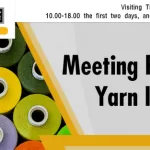The spinning process
Melt preparation and distribution : Homogenous melt forms the basis for high-quality yarn. Today, filament yarns are predominantly manufactured using direct-spinning processes and procedures. Here, the melt is produced in a poly-condensation system. Alternatively, plastic granulate can also be melted in an extruder. The melt pipes, in which the liquid polymer is forwarded to the spinning head under great pressure, are designed in accordance with the customers’ building conditions.Spinning the filament : Up to 32 filaments are simultaneously produced in the spinning head. Oerlikon Barmag spinning pumps force the melt through the spinnerets. Depending on the diameter of the spinneret, each thread consists of numerous fine threads (filaments).
Cooling and drawing : Within the subsequent quenching unit the threads are cooled and drawn over godets. Fully-automatic winding of the filaments The winders can take-up between 1 and 32 finished filaments at the same time. The design of the package size is adapted to the thickness of the filament. The winding speed ranges from 2,500 to 8,000 m/min. Switching from the full package to empty tubes is always carried out at full winding speed: without loss and fully-automatically.
The texturing process : Ever since manmade fibers were created, man has been attempting to give the smooth, synthetic filament a natural fiber-like character. Texturing is a finishing step that transforms the POY supply yarn into DTY and hence into an attractive and unique product. During texturing, pre-oriented yarn (POY) is permanently crimped using friction. As a result, elasticity and heat retention are increased, the yarn receives a pleasant handle, while thermal conduction is simultaneously reduced. Oerlikon Barmag has been offering solutions for this process step since the 1950s. Manual or automatic, single or multiple – choosing the right texturing solution for customized yarn production depends on many different factors.
Filament spinning
Precision processes for textile and industrial yarns : The principle behind manufacturing a thread is always the same: spinning pumps press the plastic melt provided by the extruder or the poly-condensation system through micro-fine spinnerets under extremely high pressure. The filaments created are then bundled into threads, drawn over godets and wound using a winder. Reliably mastering this principle requires high-precision and simultaneously extremely sturdy technology. These machines are in operation day and night, year in, year out. The slightest fault in the spinning process cannot be subsequently corrected. Oerlikon Barmag systems master the processes required for manufacturing textile and industrial yarns and spin the standard polymers polyester, polyamide and polypropylene. Furthermore, we have also taken on the challenge of processing complex materials such as PTT, aramid, carbon fibers, glass fibers and similar.
Zweigniederlassung der Oerlikon Textile GmbH & Co. KG (Oerlikon Barmag)
P.O. Box 11 02 40, 42862 Remscheid, Germany Ph: +49 21 91 67-0 Fax: +49 21 91 67-1204
Email : info@barmag.de Website www.oerlikon.com





